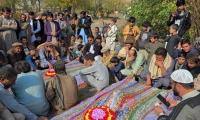The year 2019 was a spike year for dengue according to the epidemiological patterns of the last 10 years. The first spike was seen in 2011 when we lost 350 patients to this deadly virus, with total number of patients crossing 20,000 mark. A huge exercise was undertaken for management and prevention of dengue virus.
The next spike came in 2015 when 4213 patients were confirmed in the province. Given this four-year cycle, the year 2019 thus was the next spike year and so far we have seen 6919 cases in Punjab out of whom majority received treatment at public sector hospitals in Punjab.
As the disease has no vaccine, prevention becomes much more important. The key to prevention is strengthening Vector Surveillance and the environmental management of the mosquito population.
Given the scale of the problem, Punjab has learned over a period of time that prevention of dengue is as much a social problem as an epidemiological one.
Therefore, political commitment and oversight comes from the highest level for an effective response to dengue control.
Hence the Central Emergency Response Committee headed by the Chief Minister is the apex body followed by Cabinet Committee led by the Minister and then implementation committees across all tiers to ensure implementation of SOPs with micro plans in all districts.
The Cabinet Committee meetings earlier this year strongly reminded the district bodies, which are headed by Deputy Commissioners, to intensify surveillance in vulnerable localities. From March onwards the government constantly advised that this was spike year and surveillance as well larvicidal activities must be scaled up in all areas.
Tragically, a few localities in Rawalpindi in general and Potohar Town in particular, were neglected and missed by surveillance teams and this revelation was made during the June Cabinet Committee meeting.
Even though punitive action was initiated against the responsible staff in the district, yet the larva continued to grow into the mosquito and the epidemic started in Rawalpindi.
A vigorous Case Response in Punjab has managed to plateau the epidemic. The administrative and technical team of the Primary Healthcare Department led by Secretary PSH Capt (retd) Mohammad Usman is currently based in Rawalpindi to ensure personal oversight and monitoring to the case response whereas I have also been personally visiting the City once a week to monitor the working of District Emergency Response Committee.
I regularly visit the hospitals, take feedback from patients and I also monitor the surveillance activities there.
A noteworthy point is that since the epidemic began, the Chief Minister has personally chaired the DERC meetings in Rawalpindi, Sargodha and Faisalabad many times to continuously monitor the progress regarding prevention and treatment.
As far as treatment is concerned, more than 1200 beds are allocated in Rawalpindi alone as emergency was declared there.
A 15 Minute Protocol has been devised for dengue patients visiting public sector hospitals. Further, not just dengue tests and medicines are provided free of cost in all government hospitals, all other tests i.e. LFTs, are also provided completely free to the patients.
During the last six weeks, no complaint has been received regarding treatment and prevention. Five mobile health units were mobilized and sent to Rawalpindi to manage and screen people in the affected areas. Due to effective Case Response, we have been able to reduce the number of new cases by a significant margin. For example, on 30th September 2019, as many as 186 cases were reported. As on 16 October, 119 cases were reported and they are declining day by day.
In order to ensure an effective response to dengue control, we have hired dedicated 7235 staff that will help boost the surveillance at locations vulnerable for mosquito breeding. Besides good quality training, we are also devising a stringent monitoring system for this staff.
It is important to note that dengue has emerged as a global pandemic taking Asia by surprise. Philippines have been worst hit in Asia.
The number of cases has reached 322,694 in 2019 from 149,849 in 2018. Thailand reported 37,000 cases in 2018, but in 2019, the number has soared up to 136,000.
In Malaysia cases have risen from 53,800 in 2018 to 102,734 in 2019. In Cambodia, the number has taken a giant leap from just 6000 to 38,000 in last one year. In Vietnam, the cases have witnessed an increase from 37,200 in 2018 to 124,751 in 2019. In terms of scale, it is now prevalent in 110 countries spreading fast into the neighboring sub tropical regions like ours.
However, the point of concern is that even countries renowned for advanced research facilities have struggled to control the disease.
Singapore, which recorded a rise in cases from 2000 to 12840 in one year, is still looking for panacea for controlling the disease.
Research is underway globally for effective treatment and vaccination for dengue virus. On our part, we must revise our strategies and improve the SOPs based on lessons learnt.
However, one thing is certain: awareness in the community resulting in community participation will eventually help us to control dengue through structured preventive interventions.
(The writer is provincial minister for health, Punjab)
This article reflects on key sporting moments, featuring Pakistan’s triumphs and shortcomings throughout 2024
JUIF’s legal adviser, Senator Kamran Murtaza, is also engaged in consultation process
Sit-in Action Committee decides to call a grand jirga for recovery of Muasawar Kakar
Abbasi says that neither government nor opposition sincerely intended dialogue







